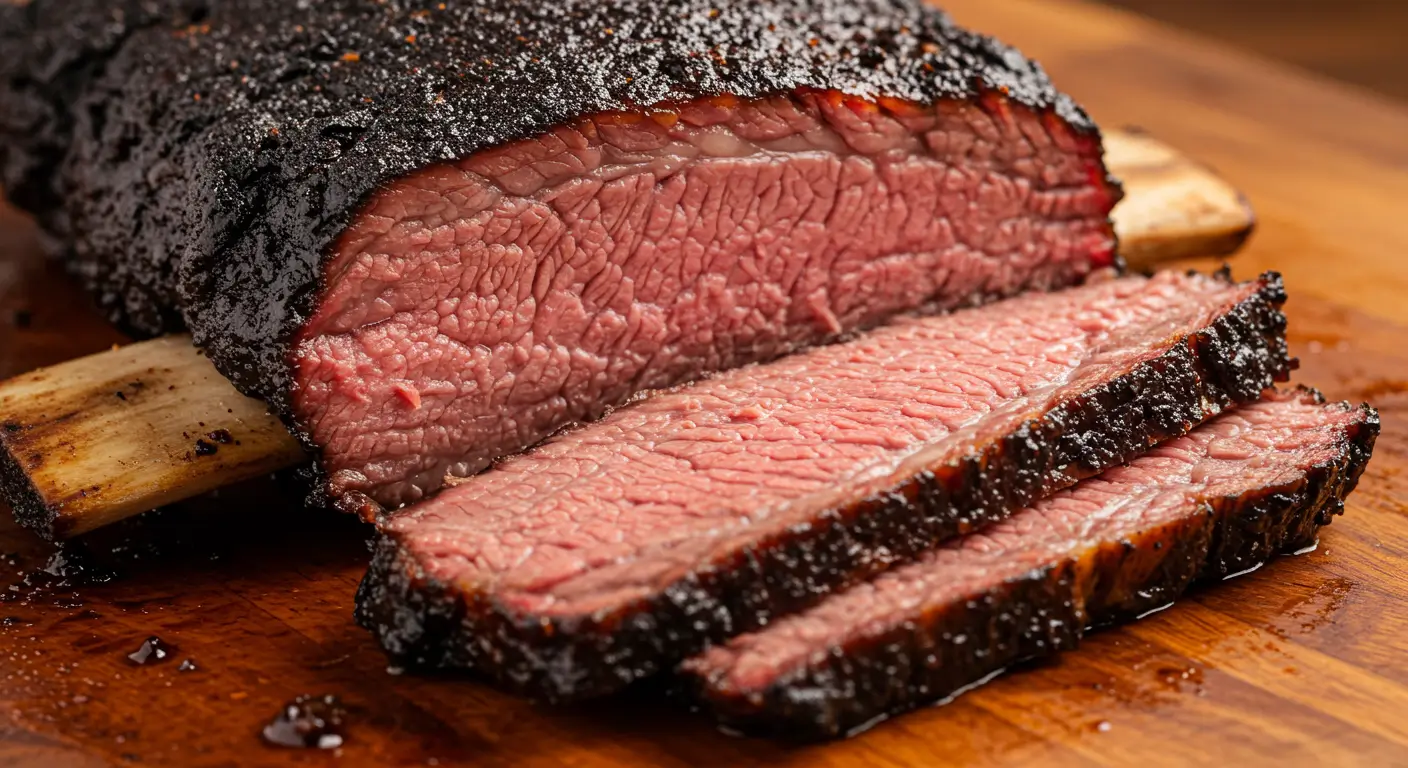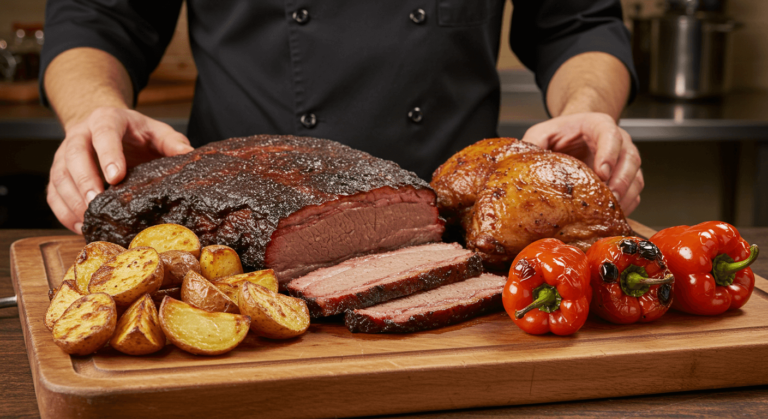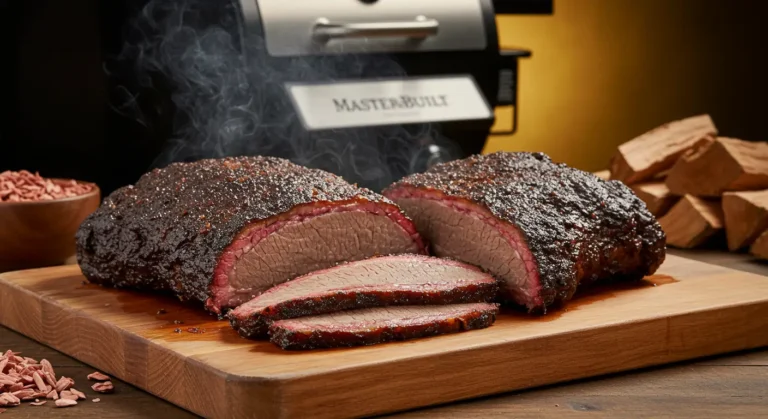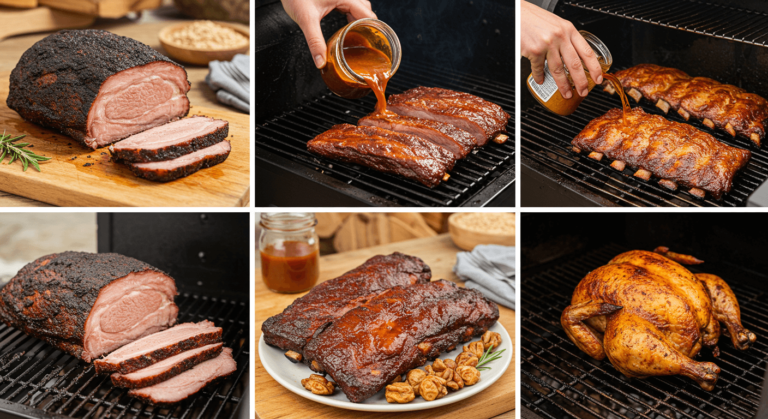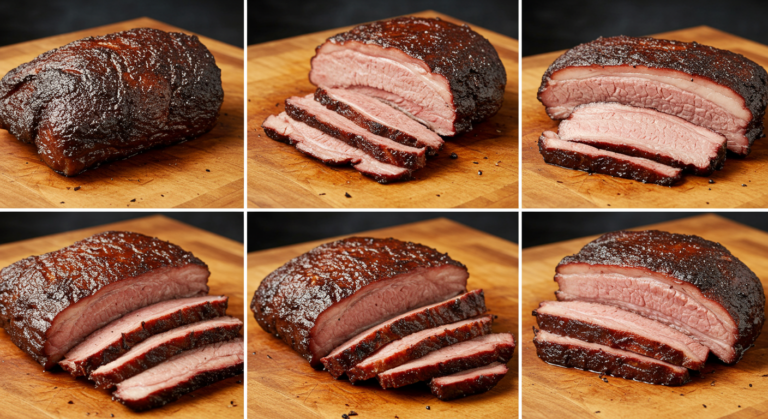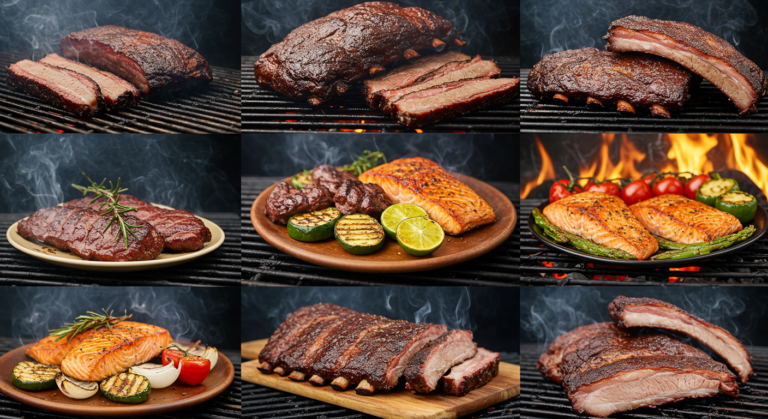How to make smoked beef short ribs: A step-by-step guide
There’s something almost magical about the moment you bite into perfectly smoked beef short ribs recipe. That beautiful pink smoke ring surrounding tender, succulent meat that practically melts in your mouth. The rich, complex flavors developed through hours of patient smoking create an experience that’s impossible to replicate with any other cooking method.
Whether you’re firing up your smoker for the first time or looking to perfect your technique, this comprehensive guide will walk you through everything you need to know about creating mouthwatering smoked beef short ribs recipe. From selecting the right cut to achieving that perfect bark, we’ve got you covered with expert techniques, time-tested tips, and foolproof methods to ensure your success.
What Makes Smoking Different from Other Cooking Methods?
Smoking is a unique cooking method that combines the transformative power of indirect heat with the flavor-enhancing properties of wood smoke. Unlike grilling, which uses direct, high heat for quick cooking, smoking utilizes lower temperatures (typically 225-275°F) over extended periods. This slow approach allows tough cuts with abundant connective tissue—like beef short ribs—to gradually break down into something extraordinary.
“Smoking isn’t just cooking—it’s a journey of transformation. You’re not just applying heat; you’re creating an environment where time, temperature, and smoke work together to develop flavors that can’t be rushed,” says award-winning pitmaster Aaron Franklin.
How Do I Choose the Best Beef Short Ribs for Smoking?
What cuts of beef short ribs work best for smoking?
When selecting beef short ribs for smoking, you have a few options, each offering slightly different experiences:
Plate Short Ribs (NAMP 123): Often called “dinosaur ribs” due to their impressive size, these come from the lower portion of the rib cage and feature thick, meaty portions with excellent marbling. These substantial cuts (usually 2-3 ribs) are perfect for long smoking sessions and deliver that classic “fall-off-the-bone” experience.
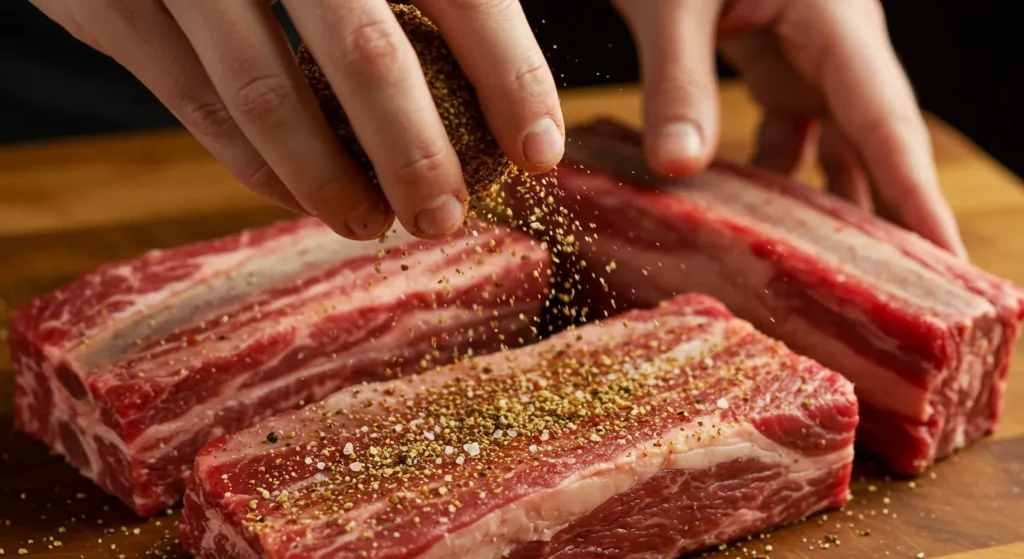
Chuck Short Ribs (NAMP 130): These come from the upper portion of the rib cage (ribs 1-5) and are generally smaller than plate ribs but offer excellent marbling and flavor. They’re a fantastic option for shorter smoking sessions.
English-Cut vs. Flanken-Style: English-cut ribs are cut parallel to the bone, resulting in a thick piece of meat sitting on top of the bone. Flanken-style ribs are cut across the bone, resulting in thinner strips with multiple bone cross-sections. For traditional smoking, English-cut is typically preferred.
How do I select quality beef short ribs?
Look for:
- Deep, rich red color with abundant marbling
- Thickness of at least 1-2 inches of meat above the bone
- Fresh-looking, moist appearance without any gray discoloration
- USDA Choice or Prime grades for optimal marbling
- A good layer of fat that will render during smoking
“The quality of your ribs will dramatically impact your end result. Don’t skimp here—look for well-marbled beef with good fat content. That’s your flavor and moisture insurance policy,” advises BBQ competition champion Myron Mixon.
The Art and Science of Smoking Beef Short Ribs recipe
How does the smoking process work?
Smoking beef short ribs is a beautiful blend of science and patience. During the process, several transformations occur:
- Muscle fibers contract: As the meat begins to heat, proteins denature and contract, squeezing out moisture. This is why meat initially becomes tougher before it becomes tender.
- Collagen conversion: Around 160°F, the collagen in the meat (abundant in short ribs) begins breaking down into gelatin, creating that signature mouthfeel and tenderness.
- Fat rendering: The intramuscular fat slowly melts, basting the meat from within and carrying flavors throughout.
- Smoke penetration: The particulate matter in wood smoke adheres to the meat surface, while smaller compounds penetrate deeper, creating layers of flavor.
- Bark formation: The exterior develops a flavorful crust through the Maillard reaction (a chemical reaction between amino acids and reducing sugars).
Which wood types work best for beef short ribs?
The wood you choose significantly impacts your final flavor profile:
- Oak: The gold standard for beef smoking, providing a medium-strong flavor that complements without overpowering
- Hickory: Delivers a stronger, bacon-like flavor that pairs beautifully with beef
- Mesquite: Offers an intensely smoky, earthy flavor (use sparingly or blend with milder woods)
- Cherry or Apple: Milder fruit woods that add subtle sweetness and attractive color
- Pecan: Creates a nutty, sweet profile between hickory and fruit woods in intensity
Many pitmasters prefer to use a blend, such as oak for the base heat and flavor with a bit of cherry for color and sweetness.
What is the “stall” and how do I manage it?
The dreaded “stall” occurs when your meat’s internal temperature plateaus—often around 150-170°F—despite the smoker maintaining constant heat. This happens because the meat’s surface evaporative cooling temporarily matches the rate of heat absorption.
To manage the stall:
- Be patient: Sometimes simply waiting it out is the purist approach
- Wrap in butcher paper or foil: Known as the “Texas crutch,” this reduces evaporative cooling and helps push through the stall
- Increase smoker temperature slightly: A small bump in temperature can help overcome the evaporative effect
Essential Equipment for Smoked Beef Short Ribs recipe
What type of smoker should I use?
While you can smoke delicious beef short ribs on virtually any smoker, each type offers different advantages:
Offset Smokers: These traditional “stick burners” are favored by purists for their excellent smoke flow and authentic flavor development. They require more attention to fire management but reward you with exceptional results.
Pellet Smokers: Offer convenience with consistent temperature control and good smoke flavor. Perfect for beginners or those who want to “set it and forget it.”
Kamado/Ceramic Smokers: Excellent heat retention makes these efficient for long cooks, though they sometimes require practice to manage smoke levels.
Electric Smokers: The ultimate in convenience, though purists might find the smoke flavor less pronounced.
Kettle Grills: With proper setup for indirect heat, even a basic Weber kettle can produce excellent smoked short ribs.
What other equipment do I need?
Beyond your smoker, gather these essentials:
- Accurate meat thermometer: Preferably an instant-read digital thermometer
- Remote probe thermometer: For monitoring without opening the smoker
- Heavy-duty aluminum foil or butcher paper: For wrapping during the stall
- Spray bottle: For spritzing meat to enhance smoke adherence
- Sharp knife: For trimming and slicing
- Heat-resistant gloves: For handling hot meat safely
How Do I Prepare Beef Short Ribs for Smoking?
Trimming and Preparation
- Trim excess fat: Remove the thick silver skin from the bone side and trim the fat cap to about ¼ inch thickness. Some fat is beneficial for flavor and moisture, but too much prevents proper smoke penetration.
- Score the fat: Make shallow cuts in a crosshatch pattern on remaining fat to help it render and allow rub penetration.
- Let ribs reach room temperature: Remove from refrigeration 30-45 minutes before smoking to promote even cooking.
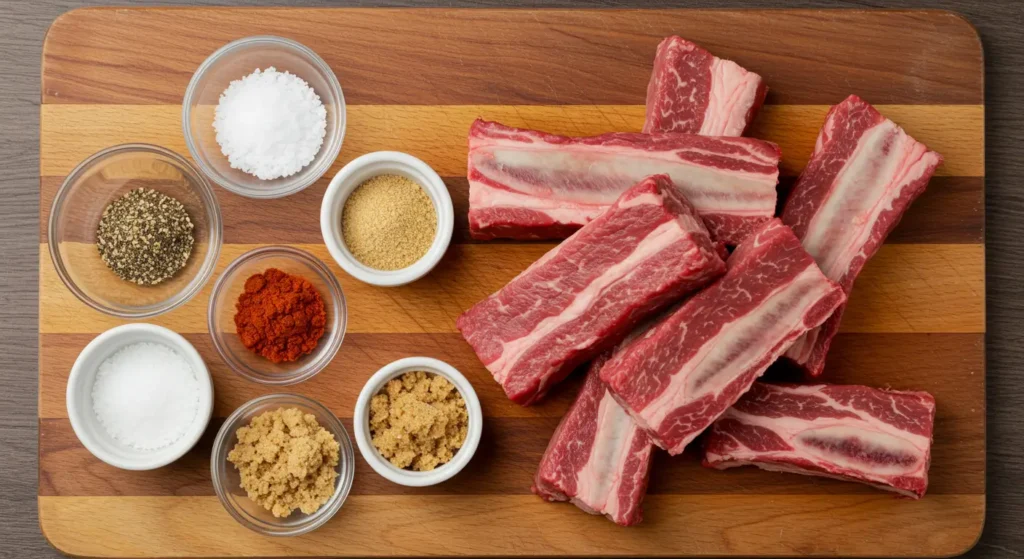
Simple vs. Complex Rubs: What works best?
For beef short ribs, both approaches have merit:
Simple Texas-Style Rub:
- 2 tablespoons kosher salt
- 2 tablespoons coarsely ground black pepper
- 1 tablespoon garlic powder
Enhanced Flavor Rub:
- 2 tablespoons kosher salt
- 2 tablespoons black pepper
- 1 tablespoon garlic powder
- 1 tablespoon onion powder
- 1 tablespoon smoked paprika
- 1 teaspoon ground coffee (enhances bark formation)
- 1 teaspoon brown sugar (aids in caramelization)
“Don’t be afraid to go heavy on the rub with beef short ribs. Unlike thinner cuts, these big meaty bones can stand up to assertive seasoning,” recommends BBQ author Meathead Goldwyn.
Apply your rub generously, pressing it into the meat to ensure adhesion. For maximum flavor development, apply 1-2 hours before smoking or even overnight.
Smoking Beef Short Ribs recipe: The Process
What’s the ideal temperature and time for smoking beef short ribs?
For optimal results:
- Smoker temperature: Maintain 250-275°F for efficient cooking while still allowing proper smoke absorption
- Target internal temperature: 200-205°F for perfect tenderness
- Expected time: 6-8 hours for plate short ribs, 4-6 hours for chuck short ribs
Remember that time is merely a guideline—temperature and tenderness are your true indicators of doneness.
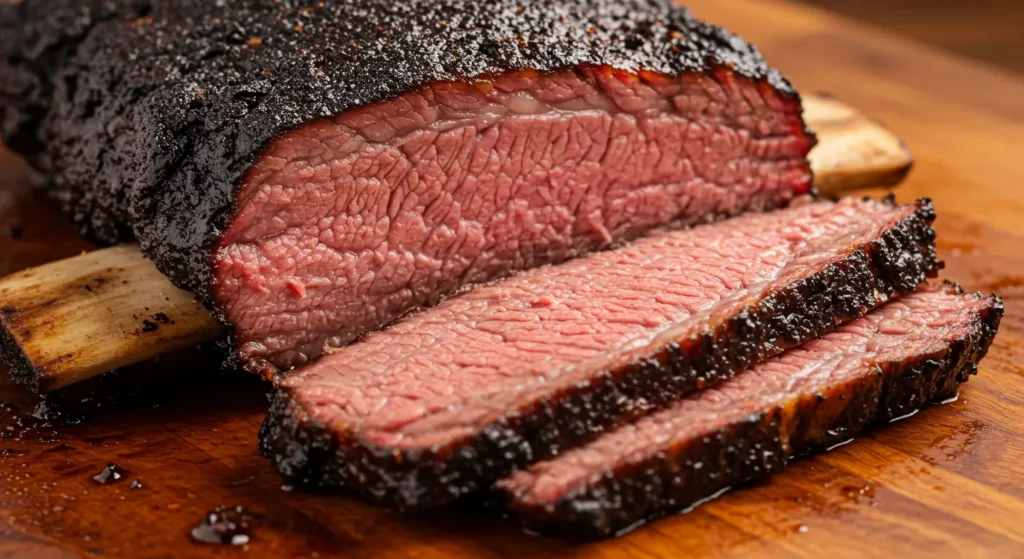
Step-by-Step Smoking Process
- Preheat your smoker to 250-275°F with your chosen wood.
- Place the seasoned ribs bone-side down on the smoker grates, fat side facing the heat source if possible.
- Maintain consistent temperature by adjusting air intakes as needed. Add wood as required to maintain thin blue smoke—avoid thick white smoke which creates bitter flavors.
- Monitor without peeking using a remote thermometer. Every time you open the smoker, you lose heat and extend cooking time.
- Optional spritz with beef broth, apple juice, or beer every hour after the first two hours to enhance smoke adherence and bark formation.
- The wrap decision: When internal temperature reaches about 165°F (typically 4-5 hours in):
- For maximum bark: Continue unwrapped
- For faster cooking: Wrap in butcher paper (moderate bark preservation)
- For tenderizing tough cuts: Wrap in foil with a splash of liquid
- Test for doneness when internal temperature reaches 200-205°F. Insert a toothpick or probe—it should slide in with minimal resistance, similar to pushing into warm butter.
How do I know when beef short ribs are done?
While temperature is important, tenderness is the ultimate test. Look for:
- Internal temperature of 200-205°F
- Probe tenderness—should slide in with almost no resistance
- Meat pulling back from the bone
- Slight jiggle when gently shaken
Resting and Serving Your Masterpiece
Why is resting important?
Resting allows the beef short ribs to complete the cooking process and reabsorb juices that would otherwise be lost if cut immediately:
- Remove ribs from smoker and wrap in butcher paper or foil if not already wrapped
- Wrap in a towel and place in a cooler (without ice) for 30-60 minutes
- This resting period allows juices to redistribute and connective tissues to finish breaking down
How should I serve smoked beef short ribs?
Presentation options:
- Serve individual ribs for an impressive presentation
- Slice meat against the grain for maximum tenderness
- Consider removing bones before serving for easier eating
Classic accompaniments:
- Tangy coleslaw to cut through the richness
- Simple sliced white bread or cornbread
- Pickled red onions or jalapeños for contrast
- Baked beans or mac and cheese for comfort food pairings
“The best way to serve beef short ribs is simply—let the meat speak for itself. A little finishing salt is all you need to highlight your hard work,” suggests chef and BBQ enthusiast Steven Raichlen.
Troubleshooting Common Issues
Why are my beef short ribs tough?
If your ribs turn out tough, consider these common culprits:
- Undercooked: The most common issue—internal temperature likely didn’t reach high enough to break down collagen (need 195°F minimum)
- Cooking too hot: High temperatures can cause meat to seize up
- Poor quality meat: Insufficient marbling or young beef with less connective tissue
- Improper slicing: Cutting with the grain instead of against it
How can I get a better smoke ring?
For that coveted pink ring:
- Ensure meat is moist when it goes on the smoker
- Use woods that produce more nitrogen dioxide (hickory, oak)
- Keep meat cold before smoking (the myoglobin responsible for the ring reacts better when cold)
- Don’t wrap too early in the process
Why is my bark soft instead of crusty?
For better bark development:
- Use rubs containing some sugar for better caramelization
- Ensure proper air flow in your smoker
- Avoid excessive spritzing
- Consider unwrapped cooking or wrapping in breathable butcher paper instead of foil
Beyond Basics: Advanced Techniques
How can I elevate my beef short ribs to competition level?
Try these advanced approaches:
- Injection: Use beef broth, butter, and seasonings to add moisture and flavor from within
- Two-stage rub application: Apply an initial binding rub, then add a second layer mid-cook
- Glaze finish: Brush with a thin layer of sauce or glaze in the final 30 minutes
- Compound butter finish: Add a slice of herb-infused butter while resting
What about sous vide and smoke combinations?
For guaranteed tenderness with smoke flavor:
- Smoke at 225°F for 3 hours to develop flavor and color
- Vacuum seal and sous vide at 155°F for 24-36 hours
- Finish on the smoker for 1 hour to refresh bark
Storing and Reheating Leftover Smoked Beef Short Ribs
If you’re fortunate enough to have leftovers:
Storage options:
- Refrigerate whole (not sliced) for up to 4 days
- Freeze vacuum-sealed portions for up to 3 months
Reheating methods:
- Wrap in foil with a splash of beef broth and heat in 275°F oven until warmed through (about 30 minutes)
- Sous vide at 155°F for 45 minutes for perfectly restored texture
- Avoid microwave reheating which can toughen the meat
- beef short ribs recipe smoked
- beef short ribs smoker recipe
- beef short ribs recipe smoker
FAQ: Common Questions About Smoking Beef Short Ribs
Your Smoking Journey
Remember that smoking beef short ribs is both an art and a science. Each smoking session is an opportunity to refine your technique and develop your personal style. Temperature control, wood selection, and patience are your most important tools.
“The true secret to great barbecue isn’t some magic rub or special technique—it’s passion and patience. Pay attention to your fire, respect the meat, and give it the time it needs,” says legendary pitmaster Tuffy Stone.
We encourage you to experiment with different wood combinations, rub variations, and serving styles to discover your signature smoked beef short ribs recipe. Document your process, noting what works and what could be improved, and soon you’ll develop an approach uniquely yours.
What techniques will you try with your next batch of smoked beef short ribs? Share your experiences in the comments below!Smoked Beef Short Ribs
Have You Tried This Recipes!
Mouthwatering Smoked Beef Short Ribs – A Must-Try Recipe
I tried this smoked beef short ribs recipe, and it turned out absolutely amazing! The seasoning blend gave the ribs a deep, smoky flavor, and the slow smoking process made them incredibly tender. The step-by-step instructions were easy to follow, and spritzing with beef broth kept the meat juicy. If you’re looking for the perfect smoked beef short ribs, this recipe is a must-try!

